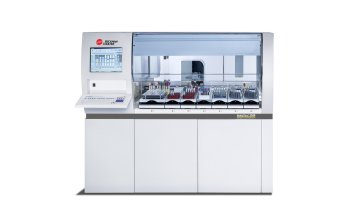St Mary's Hospital Centre
The Most Productive and Cost Efficient Core Laboratory in Quebec
The overall quality of laboratory operations has traditionally been evaluated using a combination of three variables: analytical quality, timeliness (turnaround time) and operational efficiency.

One hospital that has succeeded on all three measures simultaneously is St. Mary’s Hospital Centre (SMHC), a 414 acute-care-bed, McGill-affiliated teaching hospital located in Montreal, Quebec, Canada.
In 1998, SMHC acquired a pre-analytical automation system from Beckman Coulter for its core laboratory. Over the next five years, as the hospital’s sample volume continued to rise, the lab’s pre-analytical system was gradually upgraded, finally to become, by the end of 2003, a Total Lab Automation (TLA) system, under the direction of Ralph Dadoun, PhD, MBA, Vice-President of Corporate and Support Services.
The results of this endeavour proved to be profound – and continue to deliver prominent benefits today. Not only did the laboratory witness improved cost efficiency and quality of services, it also achieved a lower risk of human errors. Benefits include:
Higher Quality Patient Care –
SMHC’s pre-analytical automation system improved the lab’s TAT (from the lab’s receipt of the specimen to the validation of the result) by more than 50%, (90 percent of results are delivered in under 30 minutes). More importantly, the automation system drastically reduced the variability of results, which improved reliability and physician satisfaction.
By reducing the number of manipulations by more than 75 percent, robotic automation drastically reduced the number of errors and enabled the lab to catch errors that were not previously identified.
Increased Productivity and Cost Efficiency
SMHC’s overall productivity – the number of reportable results per hour worked – improved by 106% and was achieved during a 48% increase in volume and a 27% decrease in worked hours (16 FTEs).
Fewer Manual Manipulations
Automation in the laboratory, as in any other field, drastically reduces the number of manual steps needed to obtain a test result, and therefore reduces labour. At SMHC, the number of manipulations per sample dropped from 12 to two. On a typical day this represents a reduction in thousands of manual steps. Furthermore, fewer manual manipulations equates to a lower risk of exposure to blood-borne pathogens, thus increasing staff safety.
Better Use of Lab Space
By implementing a core lab, coupled with automation, the lab reduced its lab space while doubling its volume of activity. Lab space reduction: from 7,720 sq. ft. to 5,775 sq. ft. Volume of reportable results (RR): up from 1,241,000 to 2,398,339. This brought the number of RR/sq. ft. from 161 to 416.
Increased Revenues and Profits – Automation coupled with the Laboratory Information System (LIS) enabled the SMHC lab to enjoy a 60 percent growth in its outreach testing program and a substantial increase in profits.
Quick Return on Investment
SMHC achieved a pay-back period within three years. The NPV and IRR were $1.54M and 35% (respectively) over six years, with an estimated useful life of the automation system of more than 10 years.
Due to the stunning improvements evidenced at SMHC, the laboratory has received numerous awards, including one from the Canada’s Provincial Ministry of Health and Social Services, which named SMHC the Most Productive and Cost Efficient Core Laboratory in Quebec. Today, the lab continues to be a positive reference for global laboratories seeking improvements through automation.
Source: Beckman Coulter
20.12.2008











